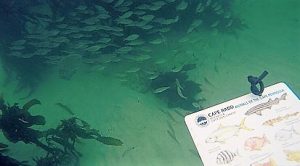False Bay, an area of natural beauty and biodiversity!
False Bay is one of the most varied and diverse areas in the world for marine life and plays host to an abundance of species large and small, from an eclectic array of colourful nudibranchs, sponges and sea anemones to mega-fauna species including the Humpback whale, seven gill sharks and of course the iconic white shark. The False Bay area offers superb dive sites and a mixture of marine habitats from rocky reef, soft corals and wreck diving to kelp forests and off shore blue water diving. This is one of many reasons why it was chosen as one of South Africa’s ‘Hope Spots’ in 2014.

What is a Hope Spot?
A Hope Spot is ‘any special place that is critical to the health of the ocean’. Hope Spots are an initiative of the Sylvia Earle Alliance which is intended to engage and encourage public support and awareness of the oceans threats and need for protection.
These areas can be large or small, and are chosen based on:
- A special abundance or diversity of species, unusual or representative species, habitats or ecosystems
- Populations of rare, threatened or endemic species
- A site with potential to reverse damage from negative human impacts
- Spectacles of nature, e.g. major migration corridors or spawning grounds
- Significant historical, cultural or spiritual values
- Economic importance to the community
These hope spots are sites that gives HOPE in the community.
There are approximately 60 Hope Spots throughout the world with most them situated in wild and remote areas far from the effects of everyday human activity. This is not the case with the South African Hope Spots as they are all based around the boundaries between nature and the local communities who benefit and manage the areas. They have been defined as places where the public are encouraged to get involved and make positive contributions to help protect and improve the areas, the quality of life for the communities and the economy.
In 2014 False Bay was selected as one of six designated South African ‘Hope Spots’ indicating the areas as places of interest and importance critical for the health of the ocean. The other five spots are the Cape Whale Coast, Knysna, Plettenberg bay, Algoa Bay, and Aliwal Shoal.
The Purpose
The intention is that collectively Hope Spots will create a global wave of community engagement, education and support for ocean conservation that will influence leaders and policy makers. Dr Sylvia Earle created this initiative to engage the public in these natural environments and believes people cannot help protect and care for something or somewhere unless they understand it, care about it and feel directly engaged with it. This relies on education and awareness of the environment to the local communities.
The direct effect of protecting these areas and improving the environment is making the areas more attractive to tourists and eco visitors, increasing tourism and thus the economy. This in turn encourages the communities to further improve and protect the area of interest.
Marine Protected areas are great examples of how the biodiversity and wild places can thrive when human activity is managed, and effective protection is put in place. The six South African Hope Spots all include Marine Protected Areas, however, unlike Marine Protected Areas Hope Spots are not governed by councils and city authorities, but are managed by the wider community, local organizations, NGOs, companies and the public directly involved with the area.
Hope spots intend to educate and inform the public in a more user friendly and easy to understand form, encouraging projects such as ‘Citizen Science’ initiatives and promoting better ways of communicating science and conservation issues. Hope Spots bring researchers and enthusiasts together from every corner, from research institutions and Universities to water sports clubs, societies, charities and schools to collaborate in a more holistic and inclusive platform.

How can you get involved?
You can get involved with your local Hope spot by volunteering and getting involved with the community projects. For example, Cape RADD offer a citizen science experience in the False Bay Hope spot, where you can assist biologists on marine fish surveys! Learn about the biodiversity and conservation projects that are happening in the area and contribute ‘real data’ to research projects. Cape RADD also get involved with beach cleans and plastic awareness projects which helps spread awareness of these issues.
You can also join Free Citizen Science databases such as iNaturalist and input your sightings and photos. iNaturalist is an online social network database of observations from naturalists, citizen scientists, and biologists whose observations help record and monitor biodiversity.
